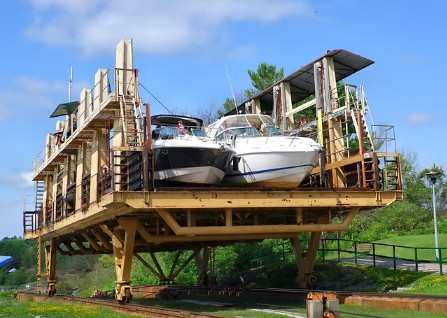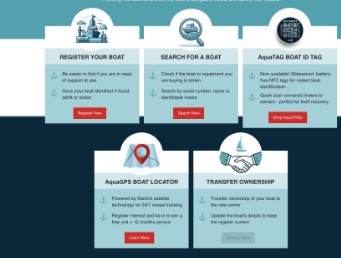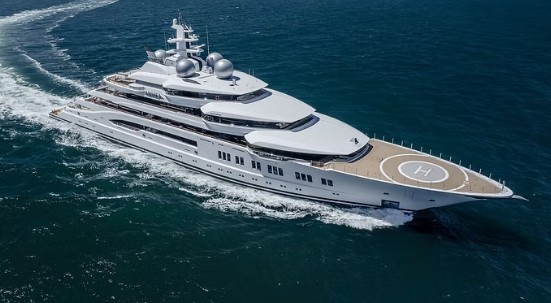Ride the rails on Canada’s big chute marine railway

This story brought a smile to my face. The Big Chute Marine Railway is clearly unique and is arguably one of Canada’s greatest marine engineering achievements. I learned it was created out of necessity, improved through ingenuity, and maintained through environmental awareness and practicality. It’s a unique experience, unlike anything recreational boaters will find around the world. If it isn’t on your boating bucket list, I am reliably informed that it should be.
Big Chute Marine Railway is located on the Trent–Severn Waterway, a 386-kilometer meandering waterway that connects Lake Ontario and Georgian Bay, in the heart of Port Severn, Ontario. Cruiser owners doing the Great Loop or travelling the vast Great Lakes system use this waterway as a cornerstone of the region, which serves as a crucial link in Ontario’s complex boating network. For well over a century, the area has become a haven for both long-distance traveller and local boaters looking for a distinctive experience while navigating through Lake Huron, Georgian Bay, Lake Simcoe, and onward toward Lake Ontario without ever leaving the province.
Before highways and cottage-country tourism, the waterways surrounding the Severn River were used for logging, transportation, and settlement. These early industries were heavily dependent on the river routes to get needed supplies to needed locales. The Trent–Severn Waterway was, and still is, a picturesque meandering network of lakes, rivers, and channels carved through the granite and pines of the Canadian Shield. By the time boating became a popular pastime in the early 20th century, the most challenging engineering problem was at its western end, where the waterway meets Georgian Bay. The Severn River plunges precipitously through rough terrain near Big Chute, forming a striking barrier that made a traditional lock system expensive, difficult, and possibly hazardous to implement.
As you might expect, the Big Chute experience leaves a lasting impression. The marine railway is more like a ride than a traditional lock, where the sensation is just rising or falling with the water level. My recommendation is, if you get the chance, be sure to experience it.
NZ Boat Register: Digital ID system aims to modernise boat ownership
 I turn to New Zealand for maritime innovation on occasion, and for a small nation, they often push above their weight. The launch of a digital ID system caught my attention, and I wanted to share it with you.
I turn to New Zealand for maritime innovation on occasion, and for a small nation, they often push above their weight. The launch of a digital ID system caught my attention, and I wanted to share it with you.
Yes, it seems New Zealand’s boating world has taken a digital leap of faith with the launch of the NZ Boat Register, a free online platform that gives recreational vessels their own verified digital identity. The system promises to streamline everything from insurance and rescue response to maintenance records and ownership transfers — while helping to reduce marine fraud and improve traceability.
Co-founder Sam Allen says the idea came from a simple frustration shared across the marine sector. He said, “Insurers want to help boat owners, but they’re working with limited infrastructure. When underwriters spend over an hour gathering basic boat details, that cost often gets passed to customers. We’re helping fix the data problem.”
Boat owners can upload photos, serial numbers, safety gear inventories, and maintenance histories into a secure digital record — all stored free of charge at nzboatregister.co.nz. For insurance providers, the platform offers structured vessel data and photographic documentation to support underwriting or claims. Emergency services can use the same system to identify found vessels and contact registered owners quickly — a step that could save valuable minutes during an on-water rescue.
Already, early adopters within the marine industry are recognising its value. Several insurers are exploring integration options, and Coastguard crews have expressed interest in using the register to support recovery operations and lost-vessel identification. While it’s not an official proof of ownership – that remains the domain of Maritime NZ – the register represents a major step forward in how New Zealand manages its vast recreational fleet.
Amadea finally sold at auction

The ongoing saga surrounding the superyacht Amadea following her seizure in Fiji in 2022 is finally over and she has a new owner. But this was far from a simple exercise I am informed in what has been a bitter legal wrangle. The auction was announced in August 2025 with a strict set of parameters to satisfy everyone involved, including the U.S. government and a team of lawyers still contesting Russian oligarch Suleyman Kerimov’s ownership.
Despite Kerimov’s lawyers claiming those parameters were not satisfied, the sale of the vessel was completed after bidding closed on September 10th.
The 106-meter (347 foot) vessel was built by Lürssen and only launched in 2021 with an estimated $230 million USD price tag. Despite being idle for nearly four years, Amadea is still one of the most advanced superyachts currently on the water. She boasts luxury features like a foredeck helipad, swimming pool, wine cellar and humidor, spa and sauna rooms, and a fire pit on the owner’s deck.
As for the auction, qualified buyers would surely have been a select few. The rules set by U.S courts demanded bidders submit a $11.6 million USD deposit in order to qualify and also had to demonstrate a net worth of at least $500 million in order to participate. The winning bidder had to make a deposit of an additional $10 million into escrow within 10 days of the auction closing and pay the remaining balance within 28 calendar days. Sadly, the U.S. Marshals Service did not confirm the winning bid price.
Britain is losing its seafarers

This is a story of concern for those of us who still consider Britain to be a significant seafaring nation. Yes, it seems Britain is losing its seafarers, and we only have ourselves to blame, it seems. But I suspect the UK is not the only nation to be faced with this shrinking phenomenon.
I have read that we must look at ourselves as an industry to see why we are losing crew members. It is not just about numbers on a spreadsheet. It is about what kind of industry we want to be and whether we are prepared to value the people who make it work. A new report commissioned by the Maritime Charities Group (MCG) has revealed that due to burnout and safety concerns, the UK’s diverse seafaring community is vanishing at an unprecedented rate. Currently, the community – defined as active seafarers, former seafarers, and dependent children – is estimated at more than half a million. By 2040, the community is projected to decline in the most extreme scenario to as low as 131,000.
As we know, life at sea is often marked by long hours, poor rest and isolation. These are not small irritations that can be solved with a motivational poster or a webinar about resilience. They are deep-rooted issues that make people leave and stop others from joining in the first place. Charities do what they can, and many do excellent work, but they should not be expected to hold the industry together. We have normalized a culture where wellbeing is seen as optional, something to be discussed at conferences, but rarely embedded in daily operations. Crew wellbeing is not a side topic. It is the foundation of safe, efficient, and sustainable shipping.
Let’s face it, there are many other options for a would-be seafarer to consider in 2025 that offer a more amenable career choice and outlook on the face of it.
Charity launches campaign to celebrate seafarers’ recipes and stories
 Let’s end this year’s What caught my eye column on a cheerier note. I read about this initiative being promoted by Stella Maris UK. They have launched a novel campaign that celebrates seafarers’ cooking skills and resourcefulness to prepare nourishing meals at sea. It sounds like a great idea to me and one I am happy to support and share with you.
Let’s end this year’s What caught my eye column on a cheerier note. I read about this initiative being promoted by Stella Maris UK. They have launched a novel campaign that celebrates seafarers’ cooking skills and resourcefulness to prepare nourishing meals at sea. It sounds like a great idea to me and one I am happy to support and share with you.
The charity is asking seafarers to share their recipes for food that gives them sustenance on board – from breakfasts that fuel the day ahead, to comforting main meals that bring crews together, to energy-giving quick snacks for a busy watch. At the end of the campaign, Stella Maris intends to publish a new seafarers’ cookbook dedicated to seafarers, filled with chosen recipes from crews around the world. Recipes featured in the cookbook will win a US $50 prize each.
Tim Hill, CEO and National Director of Stella Maris UK, said, “Access to nutritious, healthy food on board can be a challenge for many crew members. Long stretches away from port, limited supplies, tight budgets and unpredictable schedules can make it difficult to provide balanced meals.” He added that meals can become repetitive, yet seafarers show remarkable skill and resourcefulness in turning whatever is available into nourishing dishes that keep people going on long voyages.
I have thoroughly enjoyed resourcing the many stories I have shared with you this year, some of them serious, others quirky and occasionally downright silly. It has surprised me how many people enjoy this column, so I vow to keep it going in 2026.
Mike Schwarz